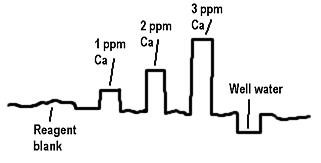

The distilled water is contaminated with calcium. Since distilled water was used to prepare the standards and the reagent blanks, those signals are significantly higher than the well water, which was not diluted with the laboratory distilled water. The laboratory distillation apparatus needs to be checked for leaks that would allow contamination of the distilled water with tap water. The technician will need to find another source of distilled water before she continues with the analysis. Furthermore, while she was fortunate that the well water samples weren't diluted with the contaminated distilled water, other samples in her laboratory that were diluted with distilled water are very likely useless. It is critical for AA analysis that quality control be maintained on the distilled water supply, since it is used both to dilute samples and as a wash between samples during analysis. A good approach to this, particularly if conductivity cannot monitored constantly, is to place a large mixed-bed ion-exchange column at the outlet of the water supply to catch any contaminants that may show up in the interval between water supply checks.